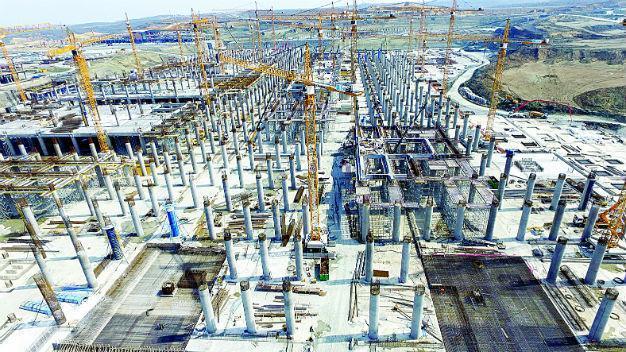On China and the world of the future
GRZEGORZ W. KOLODKO Kozminski University, Former Minister of Finance and Former Deputy Prime Minister of Poland

Asia as the emerging power is much more than China. The continent’s volume of output and population size are growing fast, accounting for more than 62 percent of the whole planet’s population, 57.5 percent of which is outside of the Middle East, often treated separately for geopolitical reasons. This human mass generates slightly over 46 percent of gross world product, GWP, or more than the US and EU combined.
With the Middle East excluded, it’s over 38 percent of GWP. In the future, the share of both Asian population and output will be increasing due to a higher population and economic growth. It is worth realizing that once before – or actually throughout all the centuries of the last millennium until around 1820, when the West took off with a bang as a result of the industrial revolution – Asia used to produce over 60 percent of the global output.
In 1950, this was less than 20 percent but it took only two generations for this index to more than double. Maybe as early as in 2030 it will be over half again. There are many forecasts available and there’s no point in arguing over which of them is the most likely one. All of them rightly indicate a significant growth of Asia’s importance in the global economy and a decline in the relative position of the West. Angus Maddison, the author of a study about the growth of the global economy in the last two millennia, estimates that in 2030 China’s share will amount to 23.8, that of India to 10.4, that of Japan to 3.6 and that of other Asian countries to 15.4 percent of GWP.
According to these predictions, the United States will have a 17.3 percent share of the global output, while Asia as a whole will contribute as much as 53 percent.
Africa is underestimated, with its share of GWP projected to fall from 3.2 percent in 2003 to 3 percent in 2030, and so are the economies of the former Soviet Union and Central and Eastern Europe, whose share is expected to decrease from 6.1 to 4.7 percent. Asia will have a dominant position in all this mass, mostly due to the size of its population rather than per capita volume of the output. The West will dominate for many more generations.
The fact that the sun rises in the east and sets in the west does not at all implicate that the East is rising and the West is falling into a dark abyss. Relations are dramatically changing but the West will not be marginalized by the East, only its relative position will be weakened. It’s true that we could make quite a movie about a panicking world where dollar is collapsing and everybody is turning away from it, toward the Chinese Yuan and the Korean won, though not towards the Indian rupee or the Thai bhat, but it would be a sci-fi movie rather than one showing the coming future. The Asian continent is culturally, politically and economically very diverse.
Especially if we take it literally, in geographic terms, and trace its borders from Turkey and Israel in the West to Japan and the Russian Siberia with Kamchatka and Chukotka in the Far East. Leaving aside the Asian part of Russia, which usually isn’t taken into account in Asian calculations, its four main cores are China and Japan, as well as two regional integration blocs: ASEAN in the SouthEast Asia, with no dominant economy, and SAARC in the South Asia, dominated by India, a regional superpower in terms of population size as well as of the economic and military strength. Of the 12 countries with a population of over 100 million as many as seven: China, India, Indonesia, Pakistan, Bangladesh, Japan and the Philippines, are situated in Asia.
Soon Vietnam and Turkey will join their ranks. Of the twenty economies that produce more than one percent of the global output, eight: China, India, Japan, South Korea, Indonesia, Turkey, Iran and Taiwan, are in Asia.
Therefore, when reflecting on the future role of Asia, its demographic potential and culture, political significance and especially its economic influence, we need to remember that it’s the world’s largest region, almost in every respect.
It is beyond any doubt that China’s absolute position – economic and, consequently, as is always the case for a large country, political and military one – as well as its impact on what is going on in the world are growing and they will continue to, in the foreseeable future.
This process cannot be stopped, or even less so reversed using peaceful methods. And other methods are out of the question. Everybody else must acknowledge this, regardless of their own interests and subjective affinities. We need to take a leap forward again and try and find the right place for ourselves in the changing world of the future.
 Asia as the emerging power is much more than China. The continent’s volume of output and population size are growing fast, accounting for more than 62 percent of the whole planet’s population, 57.5 percent of which is outside of the Middle East, often treated separately for geopolitical reasons. This human mass generates slightly over 46 percent of gross world product, GWP, or more than the US and EU combined.
Asia as the emerging power is much more than China. The continent’s volume of output and population size are growing fast, accounting for more than 62 percent of the whole planet’s population, 57.5 percent of which is outside of the Middle East, often treated separately for geopolitical reasons. This human mass generates slightly over 46 percent of gross world product, GWP, or more than the US and EU combined.